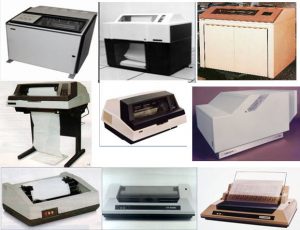VT printer families
Between 1973 and 1987, VIDEOTON had four
- character cylinder (KH, top 3 pictures)
- with character ribbon (KS, middle 1st and 2nd pictures)
- dot matrix (TM, bottom 3 images) and
- laser beam (LS, middle 3rd picture)
developed and launched a family of printers.
License-based localization
-in the case of the KH and KS families, the company DataProducts (USA),
- in the case of the TM family, under license from Walters Europe;
or own development
- in the case of LS (in cooperation with domestic and foreign companies).
István Baráth, Chief Designer - LS
Dr. Lajos Csánki, Head of Department - KH, KS
Dr. János Gantner, then István Puska, head of department - KH, KS
József Letenyei, Head of Department - TM
Gáspár Stark, Head of Department - KH, KS
Zoltán Újvári, then József Letenyei, head of department - LS
VIDEOTON Industrial and Commercial Co., Ltd. and - VIDIMPEX Foreign Trade Co., Ltd.
Use
They can be used universally in office, industrial-corporate and scientific systems for paper-based display of calculation results.
Structure
Features of the structure:
- KH and KS models
- Microprogrammed control
- Letter cylinder or steel character ribbon containing the printable character set
- Hammer set
- Roller and belt drive motors
- Paper and ribbon transport mechanism
- TM models
- Microprogrammed control
- Number of pins corresponding to the row width
- Paper and ribbon transport mechanism
- LS modell:
- laser beam control electronics
- automatic document feeder
Channel interfaces:
- Centronics parallel interface:
- KH, KS, TM
- emulated: LS
- IBM multiplex/selector: KH, KS
- V24: TM
- IEE 488: TM
- BSI (emulated): LS
Operation
KH and KS type models
There are as many lines on the character cylinder as there are elements in the character set, with each character repeated in each line as many times as the line width is.
The string contains the elements of the character set in alphabetical order, usually in two or three complete sequences to increase speed.
Printing is done line by line. When a character to be printed is brought to the front of the paper, the hammers corresponding to its position in the line strike the ink ribbon; thus, during one revolution of the character cylinder or one revolution of the character ribbon, all the characters to be printed appear in the line one by one.
TM type models
The printer has as many pin matrices in a row as the number of characters in the row width. Each pin matrix contains 9*9 printer pins; pressing a pin leaves a dot on the paper. Each character is drawn from dots, and the pin combination corresponding to the current character is set by the print control program.
The paper feed mechanism of each type raises the perforated paper at the edges after printing a full line, usually by one line. If there is a paper control punched tape, the amount of lifting is determined by the instructions punched on it; in this case, backtracking is also possible.
LS modell
The characters are drawn from dots; the control electronics runs the laser beam through each page line as many times as there are rows of dots in each character, while the laser beam burns the required number of dots in the row of dots for the current character onto the heat-sensitive paper in each character position.
After a line has been completely drawn, the control electronics – similar to mechanical typewriters – automatically advances the page by one line (“carriage return – line feed”).
Character sets
- KH and KS type
- 64 elements (lower and upper case English alphabet letters + 12 punctuation marks)
- 96 elements (full Hungarian alphabet + writing and symbols)
- TM type
- 96 items (full Hungarian alphabet + writing and symbols)
- 64 graphic symbols
- 10 additional user-defined (e.g. national) characters
- LS type
- 96-element (full ASCII set)
Several models of each type were produced, distinguished by their identification numbers. The line width and print speed are listed in the table below:
|
||||||||||||||||||||||||||||||||||||||||||||||||||||||||||||||||||||||||||||||||||||||||||||||||||||||||||||||||||||||||||||||||||||||||||||||||||||||||||||||||||||||||||||||||||||||||||||||||||||||||||||||||||||||||||||||||||||||
Program set
Printers are controlled by programs running on the computer.
There were no
Historical curiosities
The reliable operation of the electromechanical printers (KH, KS, TM) was guaranteed by the simple mechanical structure, the few moving parts, the new, increased-strength printing hammer bed, the long-life matrix head, and the microprogrammed control.
10 prototypes of the laser beam printer (LS) were made, but they were not commercially available.
Resources
Detailed description of each printer type:
character cylinder, character ribbon, dot matrix, laser beam,
Summary overview
The documents were compiled by: Mátyás Gerlai
Created: 2017.10.17. 11:57
Last modified: 2020.08.28. 21:38

